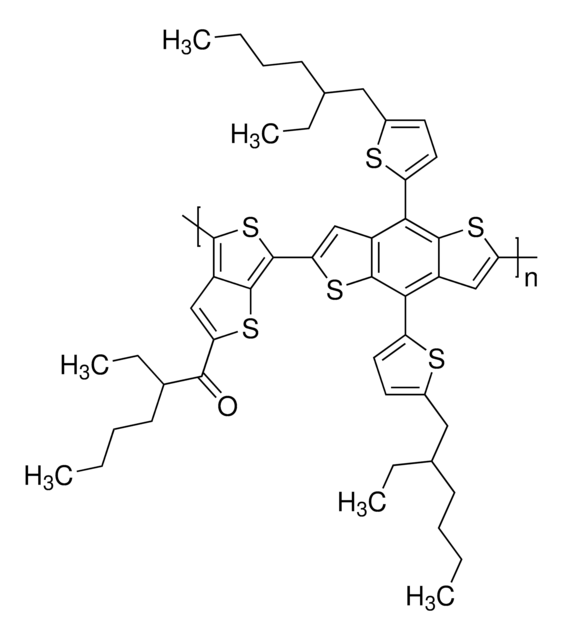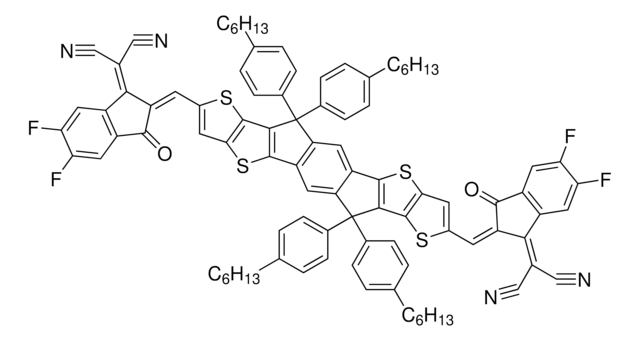772380
DTS(FBTTh2)2
Sinonimo/i:
7,7′-[4,4-Bis(2-ethylhexyl)-4H-silolo[3,2-b:4,5-b′]dithiophene-2,6-diyl]bis[6-fluoro-4-(5′-hexyl-[2,2′-bithiophen]-5-yl)benzo[c][1,2,5]thiadiazole], F-DTS, p-DTS(FBTTh2)2
About This Item
Prodotti consigliati
Forma fisica
solid
Solubilità
chlorobenzene: 0.3-0.5% at 80 °C
dichlorobenzene: 0.3-0.5% at 80 °C
chloroform: soluble(lit.)
dichlorobenzene: soluble(lit.)
λmax
590 nm in chloroform
Stringa SMILE
CCCCCCc1ccc(s1)-c2ccc(s2)-c3cc(F)c(-c4cc5c(s4)-c6sc(cc6[Si]5(CC(CC)CCCC)CC(CC)CCCC)-c7c(F)cc(-c8ccc(s8)-c9ccc(CCCCCC)s9)c%10nsnc7%10)c%11nsnc3%11
InChI
1S/C64H72F2N4S8Si/c1-7-13-17-19-23-41-25-27-49(71-41)51-31-29-47(73-51)43-33-45(65)57(61-59(43)67-77-69-61)53-35-55-63(75-53)64-56(79(55,37-39(11-5)21-15-9-3)38-40(12-6)22-16-10-4)36-54(76-64)58-46(66)34-44(60-62(58)70-78-68-60)48-30-32-52(74-48)50-28-26-42(72-50)24-20-18-14-8-2/h25-36,39-40H,7-24,37-38H2,1-6H3
LNMKMESEJYZMDZ-UHFFFAOYSA-N
Descrizione generale
Applicazioni
OPV Device Structure: ITO/MoOx/DTS(PTTh2)2: PC70BM/Al
- JSC = 12.8 mA/cm2
- VOC = 0.81 V
- FF = 0.68
- PCE = 7.0%
Codice della classe di stoccaggio
11 - Combustible Solids
Classe di pericolosità dell'acqua (WGK)
WGK 3
Punto d’infiammabilità (°F)
Not applicable
Punto d’infiammabilità (°C)
Not applicable
Certificati d'analisi (COA)
Cerca il Certificati d'analisi (COA) digitando il numero di lotto/batch corrispondente. I numeri di lotto o di batch sono stampati sull'etichetta dei prodotti dopo la parola ‘Lotto’ o ‘Batch’.
Possiedi già questo prodotto?
I documenti relativi ai prodotti acquistati recentemente sono disponibili nell’Archivio dei documenti.
Articoli
Solution-processed organic photovoltaic devices (OPVs) have emerged as a promising clean energy generating technology due to their ease of fabrication, potential to enable low-cost manufacturing via printing or coating techniques, and ability to be incorporated onto light weight, flexible substrates.
Il team dei nostri ricercatori vanta grande esperienza in tutte le aree della ricerca quali Life Science, scienza dei materiali, sintesi chimica, cromatografia, discipline analitiche, ecc..
Contatta l'Assistenza Tecnica.
![[6,6]-Phenyl C71 butyric acid methyl ester 99%](/deepweb/assets/sigmaaldrich/product/structures/716/624/9fb9f2f0-ae99-429f-8d3a-b12267976a4d/640/9fb9f2f0-ae99-429f-8d3a-b12267976a4d.png)




![Poly[4,5-difluoro-2,2-bis(trifluoromethyl)-1,3-dioxole-co-tetrafluoroethylene] dioxole 87 mol %](/deepweb/assets/sigmaaldrich/product/structures/951/320/21327fcd-4960-402d-8ae1-bf2e379cb2e2/640/21327fcd-4960-402d-8ae1-bf2e379cb2e2.png)


